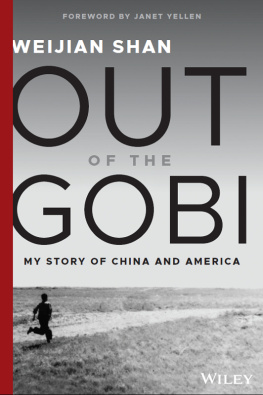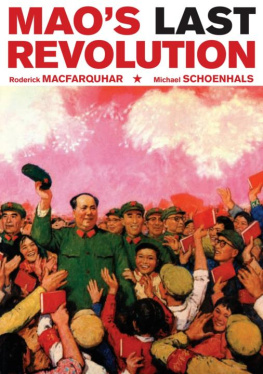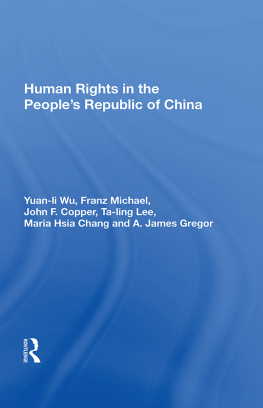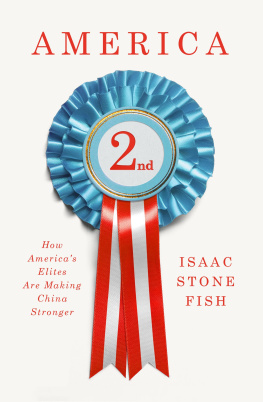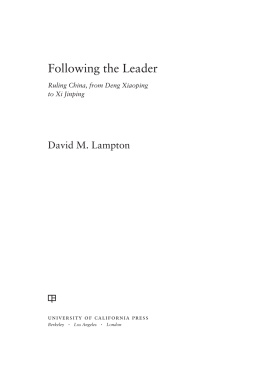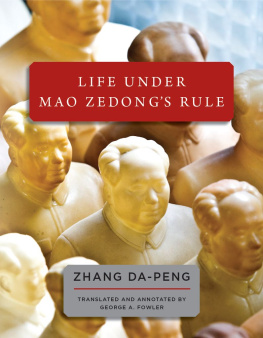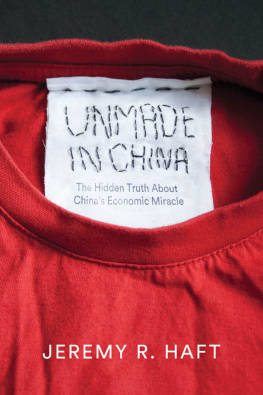
Out of the Gobi
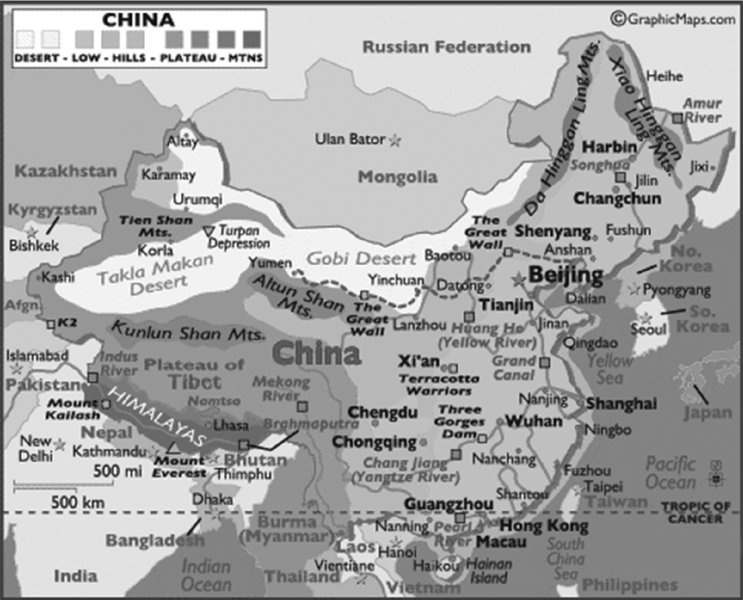
Source: WorldAtlas.com
Note: China, with a landmass of approximately 9.6 square kilometers (3.7 million square miles), is about the same size as the United States (with its landmass of 9.8 million square kilometers, or 3.8 million square miles). Chinas population of about 1.4 billion (in 2016) is more than four times that of the United States (325 million). The shape of the country reminds one of a rooster. The Gobi Desert is located on the back of the rooster, in the north. The Great Wall, shown as a dotted line, stretches from the throat of the rooster near Beijing all the way to the west, roughly parallel to the rest of the Gobi Desert for 6,259 kilometers (3,889 miles), but its total length, including all its branches, is 21,196 kilometers (13,171 miles). The Yellow River, part of which flows close to the southern edge of the Gobi Desert, is the second-longest river in China and the sixth-longest in the world, with an estimated length of 5,464 kilometers (3,395 miles).
Out of the Gobi
My Story of China
and America
Weijian Shan
Cover image: Weijian Shan, photo of the author as a boy in the Gobi
Cover design: Wiley
Copyright 2019 by Weijian Shan. All rights reserved.
Published by John Wiley & Sons, Inc., Hoboken, New Jersey.
Published simultaneously in Canada.
No part of this publication may be reproduced, stored in a retrieval system, or transmitted in any form or by any means, electronic, mechanical, photocopying, recording, scanning, or otherwise, except as permitted under Section 107 or 108 of the 1976 United States Copyright Act, without either the prior written permission of the Publisher, or authorization through payment of the appropriate per-copy fee to the Copyright Clearance Center, Inc., 222 Rosewood Drive, Danvers, MA 01923, (978) 750-8400, fax (978) 646-8600, or on the Web at www.copyright.com. Requests to the Publisher for permission should be addressed to the Permissions Department, John Wiley & Sons, Inc., 111 River Street, Hoboken, NJ 07030, (201) 748-6011, fax (201) 748-6008, or online at www.wiley.com/go/permissions.
Limit of Liability/Disclaimer of Warranty: While the publisher and author have used their best efforts in preparing this book, they make no representations or warranties with respect to the accuracy or completeness of the contents of this book and specifically disclaim any implied warranties of merchantability or fitness for a particular purpose. No warranty may be created or extended by sales representatives or written sales materials. The advice and strategies contained herein may not be suitable for your situation. You should consult with a professional where appropriate. Neither the publisher nor author shall be liable for any loss of profit or any other commercial damages, including but not limited to special, incidental, consequential, or other damages.
For general information on our other products and services or for technical support, please contact our Customer Care Department within the United States at (800) 762-2974, outside the United States at (317) 572-3993, or fax (317) 572-4002.
Wiley publishes in a variety of print and electronic formats and by print-on-demand. Some material included with standard print versions of this book may not be included in e-books or in print-on-demand. If this book refers to media such as a CD or DVD that is not included in the version you purchased, you may download this material at http://booksupport.wiley.com. For more information about Wiley products, visit www.wiley.com.
Library of Congress Cataloging-in-Publication Data:
Name: Shan, Weijian, 1953, author.
Title: Out of the Gobi : my story of China and America / Weijian Shan.
Description: Hoboken, New Jersey : John Wiley & Sons, Inc., [2019] | Includes index. |
Identifiers: LCCN 2018046912 (print) | LCCN 2018049208 (ebook) |
ISBN 978-1-119-52956-9 (Adobe PDF) | ISBN 978-1-119-52955-2 (ePub) |
ISBN 978-1-119-52949-1 (hardcover)
Subjects: LCSH: Shan, Weijian, 1953 | BusinesspeopleChinaBiography. | ChineseUnited StatesBiography. | ChinaHistory1949 | United StatesHistory1945
Classification: LCC HC426.5.S43 (ebook) | LCC HC426.5.S43 A3 2019 (print) |
DDC 338.092 [B] dc23
LC record available at https://lccn.loc.gov/2018046912
To my wife, Bin Shi, and to our son,
Bo, and daughter, LeeAnn
Foreword
The manuscript of Weijian Shans book arrived on my desk at a hectic time: I had commitments for weeks to come. But when I finally picked up the manuscript, I was so gripped by his stories that I could hardly put it down.
I have known Shan for 36 years, since he first showed up in my office on a sunny September day in 1982. He struck me as a charming young man, full of smiles, but in need of a good meal and a new haircut. He had arrived at Berkeley to start his Ph.D. program, and I was his academic advisor. I was stunned to discover that he had no formal math training. All the math he knew he had learned by himself, by candlelight. Over time, I learned a bit about Shans unique and extraordinary background growing up in China, where he was denied an education for 10 years after elementary school.
Yet I was fascinated to read his detailed account of a China gone mad during the 19661976 Cultural Revolution, of the severe hardship he and his generation had endured, of his relentless pursuit of an education through reading whatever books he could find while serving as a hard laborer in Chinas Gobi Desert at a time when almost all books were banned, and of how, against all odds, he was able to get out of the Gobi and eventually find his way to America to attend graduate school. He recounts a contemporary history of China rarely told in the English literature from a personal perspective, a history that paralleled our own tumultuous period in the 1960s and 1970s in America. His keen observation of the United States from the viewpoint of someone with a totally different cultural, political, and economic background is unique, insightful, heartwarming, and often funny. He recounts his stories with vivid clarity, short, punchy sentences, and light and dark humor. They captivate the reader, who feels as if he is watching a movie, anxious to know how the plot will unfold and where it will all end.
After earning his doctoral degree, Shan received offers of professorships from some of the most renowned American universities, including MIT and the Wharton School of the University of Pennsylvania. I remember him calling me for advice, asking which school he should choose for his academic career. I told him he couldnt go wrong at any of these top schools. As I remarked to one of my Berkeley colleagues at a celebration party on the occasion of Shans graduation in 1987, I found it mind-boggling how far he had journeyedfrom working as a hard laborer without a secondary education and with no command of English to becoming a professor at one of Americas most prestigious universities, all in about ten years.
Shans story shows the crucial role that education plays in the success of individuals and society as a whole. Moreover, Shans life provides a demonstration of what is possible when China and the United States come together, even by happenstance. It is not only Shans personal history that makes this book so interesting but also how the stories of China and America merge in just one moment in time to create an inspired individual so unique and driven, and so representative of the true spirits of both countries.
Next page
